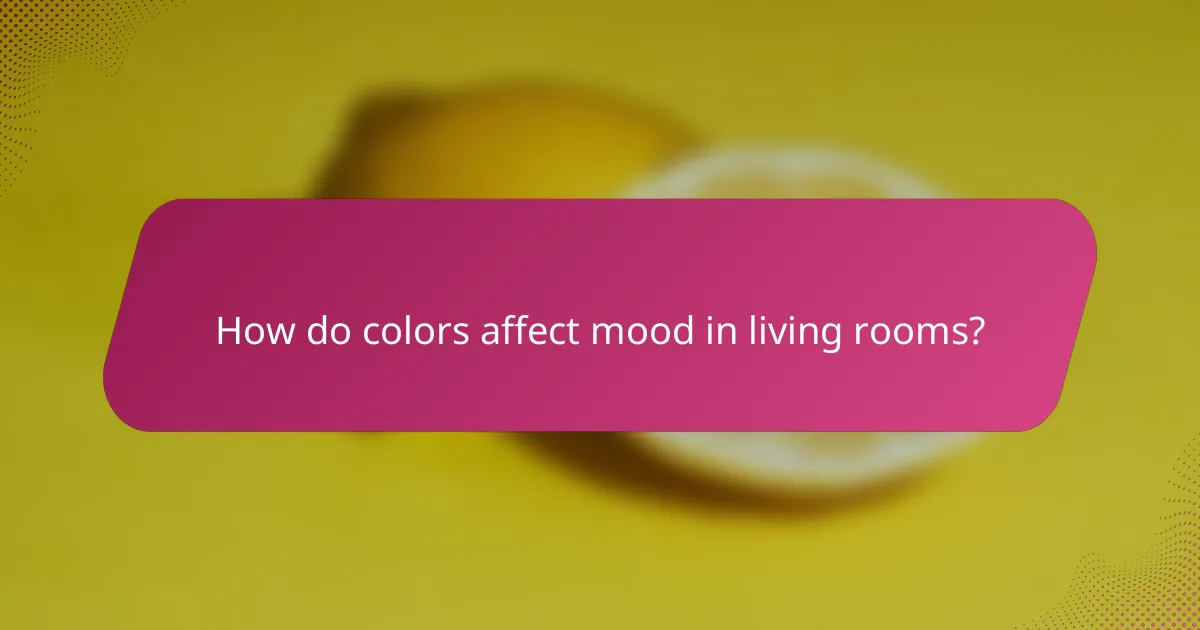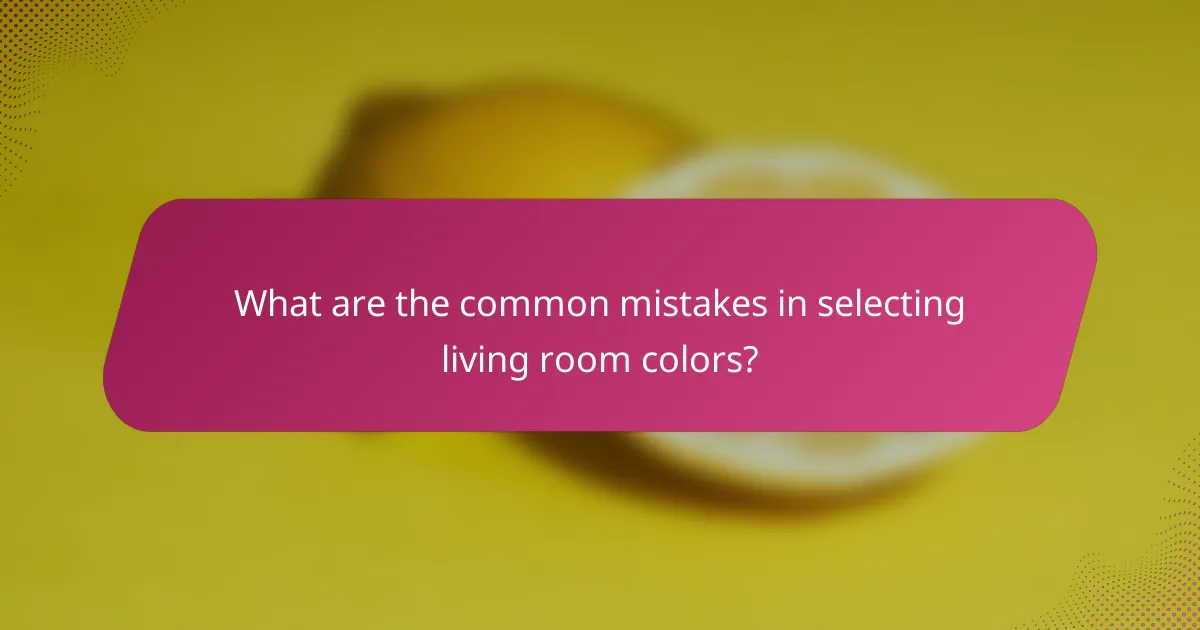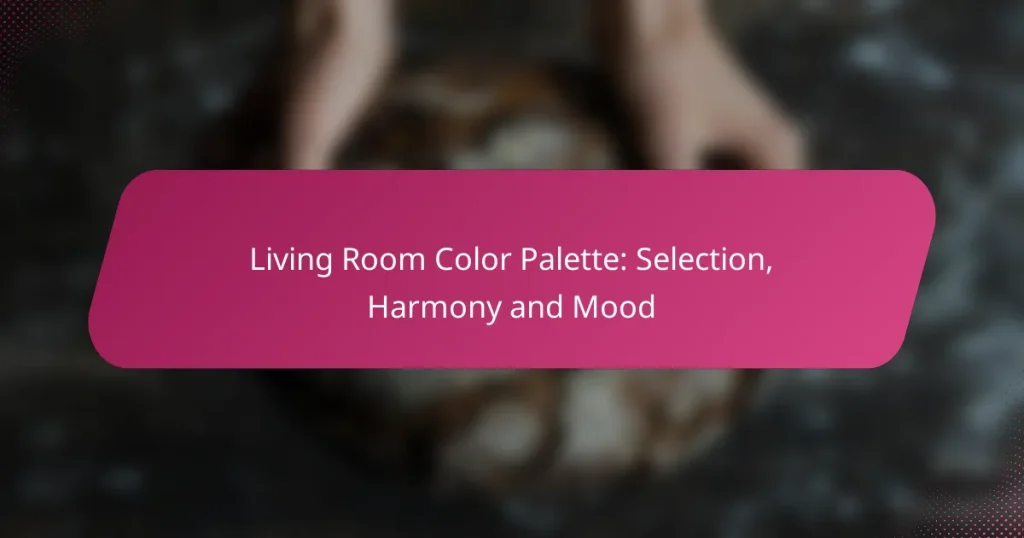Choosing the right color palette for your living room is essential for creating a space that reflects your personality and enhances your mood. By understanding the impact of colors and how they interact, you can design a harmonious environment that balances comfort and style. Whether you prefer vibrant hues or calming neutrals, the right selection can transform your living area into a welcoming retreat.

What are the best color palettes for living rooms in Los Angeles?
The best color palettes for living rooms in Los Angeles often reflect the city’s vibrant culture and sunny climate. Popular choices include neutral tones, bold colors, and earthy shades, each contributing to a unique atmosphere that can enhance comfort and style.
Neutral tones for a calming effect
Neutral tones, such as soft whites, beiges, and grays, create a serene environment ideal for relaxation. These colors can make a space feel larger and more open, which is particularly beneficial in urban settings like Los Angeles.
When selecting neutral shades, consider using a mix of textures to add depth. For example, pairing a light gray sofa with a cream-colored rug can create a sophisticated yet inviting look. Avoid overly stark whites, as they can feel cold; warmer neutrals tend to foster a more welcoming atmosphere.
Bold colors for a vibrant atmosphere
Bold colors, including deep blues, rich reds, and vibrant yellows, can energize a living room and reflect the lively spirit of Los Angeles. These hues work well as accent walls or in decorative elements like cushions and artwork.
To effectively incorporate bold colors, balance them with neutral furnishings to prevent overwhelming the space. For instance, a bright orange accent chair can pop against a muted gray sofa, creating a focal point without dominating the room. Remember to choose colors that resonate with your personal style while considering the overall mood you wish to achieve.
Earthy shades for a cozy feel
Earthy shades, such as terracotta, olive green, and warm browns, evoke a sense of comfort and connection to nature. These colors can create a cozy atmosphere, making your living room a perfect retreat from the bustling city life.
Incorporating earthy tones can be done through paint, furniture, or accessories. For example, a terracotta accent wall paired with wooden furniture can create a warm and inviting space. Consider adding plants to enhance the natural feel, as greenery complements earthy colors beautifully and improves indoor air quality.

How do colors affect mood in living rooms?
Colors significantly influence mood in living rooms by evoking emotional responses and setting the atmosphere. Choosing the right color palette can create a vibrant, energetic space or a calm, relaxing environment, depending on the hues selected.
Warm colors promote energy
Warm colors like reds, oranges, and yellows can energize a living room, making it feel lively and inviting. These colors stimulate the senses and can encourage social interaction, making them ideal for spaces where family and friends gather.
When selecting warm colors, consider using them as accents rather than dominant shades to avoid overwhelming the space. For example, a warm orange accent wall paired with neutral furniture can create a balanced yet vibrant atmosphere.
Cool colors enhance relaxation
Cool colors such as blues, greens, and purples are known for their calming effects, making them perfect for creating a serene living room. These shades can help reduce stress and promote a sense of tranquility, ideal for unwinding after a long day.
To effectively use cool colors, consider painting the walls in soft blues or greens and complementing them with lighter furniture and decor. This combination can enhance the feeling of spaciousness and peace, making the living room a perfect retreat.

What are the steps to create a harmonious living room color palette?
Creating a harmonious living room color palette involves selecting a base color, choosing complementary colors, and incorporating accent colors. This process ensures that the colors work together to create a cohesive and inviting atmosphere.
Choose a base color
The base color sets the tone for your living room and should reflect your personal style. Consider neutral shades like beige, gray, or soft pastels for a calming effect, or opt for bolder hues like navy or forest green for a more dramatic look.
When selecting a base color, test samples on your walls to see how they interact with natural light throughout the day. Aim for a color that resonates with the overall mood you want to create.
Select complementary colors
Complementary colors enhance the base color and create visual interest. Look for shades that are opposite or adjacent to your base color on the color wheel. For example, if your base is a warm beige, consider cooler shades like teal or soft blue.
Limit your complementary colors to two or three to avoid overwhelming the space. Use them in larger furniture pieces or wall art to maintain balance and harmony in the room.
Incorporate accent colors
Accent colors add pops of vibrancy and personality to your living room. These can be bold shades that contrast with your base and complementary colors, such as bright yellow or deep red. Use these sparingly in accessories like cushions, throws, or artwork.
When choosing accent colors, consider the overall color scheme and select hues that tie back to your base and complementary colors. This will ensure that the accents feel intentional and cohesive rather than random.

What tools can help with color selection for living rooms?
Several tools can assist in selecting colors for living rooms, making the process easier and more visually appealing. These tools range from mobile apps to traditional color wheels, each offering unique features to help achieve a harmonious color palette.
Paint sample apps like Sherwin-Williams ColorSnap
Paint sample apps, such as Sherwin-Williams ColorSnap, allow users to visualize colors in their living spaces using augmented reality. By uploading a photo of your room, you can experiment with different shades and finishes, helping to narrow down your choices effectively.
These apps often provide features like color matching, where you can take a picture of an object and find a corresponding paint color. This can be particularly useful for ensuring that your selected hues complement existing furniture or decor.
Color wheel tools for harmony
Color wheel tools are essential for achieving harmony in your living room’s color palette. They help you understand color relationships, such as complementary, analogous, and triadic schemes, which can guide your selection process.
When using a color wheel, consider starting with a dominant color and then selecting one or two accent colors that create balance. For example, if you choose a warm beige for the walls, a soft blue or green can serve as an excellent accent, bringing a refreshing contrast without overwhelming the space.

What are the common mistakes in selecting living room colors?
Common mistakes in selecting living room colors include neglecting the impact of natural light and choosing colors that clash with each other. These errors can lead to an uninviting atmosphere and disrupt the intended mood of the space.
Ignoring natural light effects
Natural light significantly influences how colors appear in a living room. A color that looks vibrant in a store may appear dull or overly bright in different lighting conditions. It’s essential to test paint samples in the actual room at various times of the day to see how they interact with the light.
Consider the direction of windows as well. North-facing rooms tend to receive cooler, softer light, while south-facing rooms are usually brighter and warmer. This can affect how colors are perceived, so choose shades that complement the natural light available.
Choosing colors that clash
Clashing colors can create visual chaos and discomfort in a living room. To avoid this, select a color palette that includes complementary or analogous colors. For instance, pairing a warm beige with a soft blue can create a harmonious look.
Using a color wheel can help identify colors that work well together. Additionally, consider the 60-30-10 rule: use 60% of a dominant color, 30% of a secondary color, and 10% of an accent color to maintain balance and cohesion in the space.

How can local trends influence living room color choices?
Local trends significantly shape living room color choices by reflecting the cultural, environmental, and architectural influences of a region. Homeowners often select colors that resonate with their surroundings, creating a cohesive aesthetic that feels harmonious and inviting.
Popular colors in urban areas
In urban areas, popular colors often include neutral tones like grays, whites, and beiges, which provide a modern and sophisticated backdrop. These shades are frequently accented with bold colors such as deep blues, vibrant greens, or rich reds to add personality and warmth to the space.
Urban living spaces may also embrace industrial elements, leading to the use of darker hues like charcoal or black, which can enhance the chic, contemporary vibe. Homeowners should consider the amount of natural light in their living rooms, as darker colors can make a space feel smaller if not balanced with lighter accents.
Seasonal color trends in Southern California
In Southern California, seasonal color trends often reflect the region’s sunny climate and outdoor lifestyle. Light, airy colors such as soft pastels, sandy beiges, and ocean-inspired blues are popular choices, especially in spring and summer, as they evoke a sense of relaxation and openness.
During the fall and winter months, warmer tones like terracotta, mustard yellow, and earthy greens may gain popularity, reflecting the changing landscape. Homeowners should consider incorporating seasonal accents through accessories like cushions or artwork, allowing for easy updates without a complete overhaul of their living room color palette.

What are the benefits of hiring a local interior designer for color selection?
Hiring a local interior designer for color selection offers personalized expertise and a deep understanding of local trends and preferences. They can help create a cohesive color palette that enhances the mood and functionality of your living room.
Expertise in Color Theory
Local interior designers possess a strong grasp of color theory, which allows them to select hues that complement each other and suit the intended atmosphere. They understand how colors interact with light and space, ensuring that your chosen palette will look appealing at different times of the day.
For example, a designer might recommend warm tones for a cozy feel or cool shades for a more tranquil environment. Their expertise helps avoid common pitfalls, such as clashing colors or overly bold choices that can overwhelm a space.
Access to Local Resources
Working with a local designer means they have established relationships with nearby suppliers and artisans. This access can lead to unique materials and finishes that reflect local culture and style, enhancing the overall aesthetic of your living room.
Additionally, local designers are familiar with the availability of products in your area, which can streamline the selection process and ensure timely delivery. This can save you time and effort compared to sourcing items independently.
Personalized Service and Collaboration
Local interior designers offer personalized service tailored to your specific needs and preferences. They take the time to understand your vision, lifestyle, and the existing elements in your living room, ensuring that the color selection aligns with your overall design goals.
Through collaboration, they can provide valuable feedback and suggestions, helping you navigate choices that may seem overwhelming. This partnership can lead to a more satisfying and cohesive final result.

